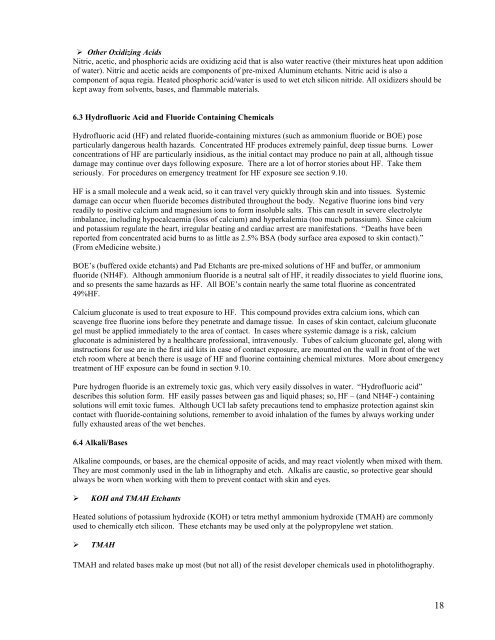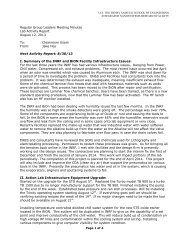Download Lab Safety Manual - Integrated Nanosystems Research ...
Download Lab Safety Manual - Integrated Nanosystems Research ...
Download Lab Safety Manual - Integrated Nanosystems Research ...
You also want an ePaper? Increase the reach of your titles
YUMPU automatically turns print PDFs into web optimized ePapers that Google loves.
‣ Other Oxidizing Acids<br />
Nitric, acetic, and phosphoric acids are oxidizing acid that is also water reactive (their mixtures heat upon addition<br />
of water). Nitric and acetic acids are components of pre-mixed Aluminum etchants. Nitric acid is also a<br />
component of aqua regia. Heated phosphoric acid/water is used to wet etch silicon nitride. All oxidizers should be<br />
kept away from solvents, bases, and flammable materials.<br />
6.3 Hydrofluoric Acid and Fluoride Containing Chemicals<br />
Hydrofluoric acid (HF) and related fluoride-containing mixtures (such as ammonium fluoride or BOE) pose<br />
particularly dangerous health hazards. Concentrated HF produces extremely painful, deep tissue burns. Lower<br />
concentrations of HF are particularly insidious, as the initial contact may produce no pain at all, although tissue<br />
damage may continue over days following exposure. There are a lot of horror stories about HF. Take them<br />
seriously. For procedures on emergency treatment for HF exposure see section 9.10.<br />
HF is a small molecule and a weak acid, so it can travel very quickly through skin and into tissues. Systemic<br />
damage can occur when fluoride becomes distributed throughout the body. Negative fluorine ions bind very<br />
readily to positive calcium and magnesium ions to form insoluble salts. This can result in severe electrolyte<br />
imbalance, including hypocalcaemia (loss of calcium) and hyperkalemia (too much potassium). Since calcium<br />
and potassium regulate the heart, irregular beating and cardiac arrest are manifestations. “Deaths have been<br />
reported from concentrated acid burns to as little as 2.5% BSA (body surface area exposed to skin contact).”<br />
(From eMedicine website.)<br />
BOE’s (buffered oxide etchants) and Pad Etchants are pre-mixed solutions of HF and buffer, or ammonium<br />
fluoride (NH4F). Although ammonium fluoride is a neutral salt of HF, it readily dissociates to yield fluorine ions,<br />
and so presents the same hazards as HF. All BOE’s contain nearly the same total fluorine as concentrated<br />
49%HF.<br />
Calcium gluconate is used to treat exposure to HF. This compound provides extra calcium ions, which can<br />
scavenge free fluorine ions before they penetrate and damage tissue. In cases of skin contact, calcium gluconate<br />
gel must be applied immediately to the area of contact. In cases where systemic damage is a risk, calcium<br />
gluconate is administered by a healthcare professional, intravenously. Tubes of calcium gluconate gel, along with<br />
instructions for use are in the first aid kits in case of contact exposure, are mounted on the wall in front of the wet<br />
etch room where at bench there is usage of HF and fluorine containing chemical mixtures. More about emergency<br />
treatment of HF exposure can be found in section 9.10.<br />
Pure hydrogen fluoride is an extremely toxic gas, which very easily dissolves in water. “Hydrofluoric acid”<br />
describes this solution form. HF easily passes between gas and liquid phases; so, HF – (and NH4F-) containing<br />
solutions will emit toxic fumes. Although UCI lab safety precautions tend to emphasize protection against skin<br />
contact with fluoride-containing solutions, remember to avoid inhalation of the fumes by always working under<br />
fully exhausted areas of the wet benches.<br />
6.4 Alkali/Bases<br />
Alkaline compounds, or bases, are the chemical opposite of acids, and may react violently when mixed with them.<br />
They are most commonly used in the lab in lithography and etch. Alkalis are caustic, so protective gear should<br />
always be worn when working with them to prevent contact with skin and eyes.<br />
‣ KOH and TMAH Etchants<br />
Heated solutions of potassium hydroxide (KOH) or tetra methyl ammonium hydroxide (TMAH) are commonly<br />
used to chemically etch silicon. These etchants may be used only at the polypropylene wet station.<br />
‣ TMAH<br />
TMAH and related bases make up most (but not all) of the resist developer chemicals used in photolithography.<br />
18



